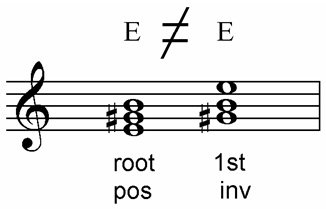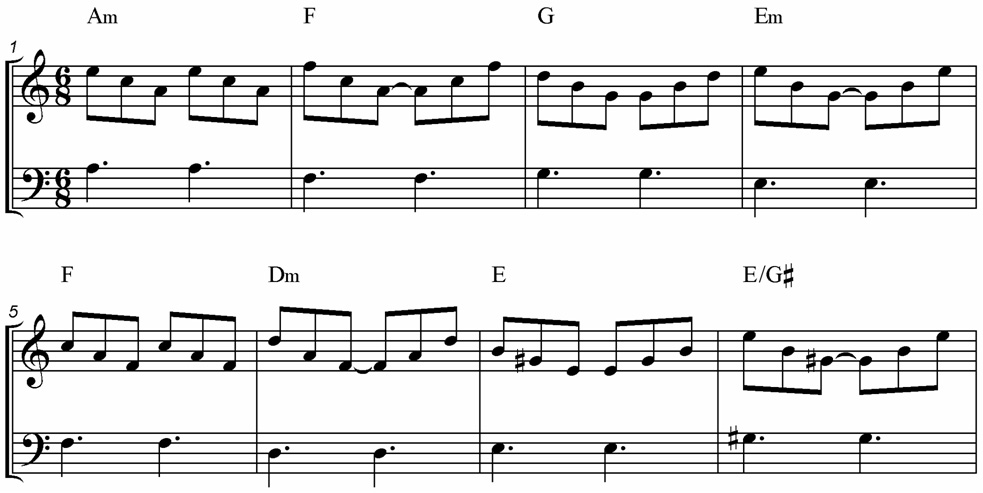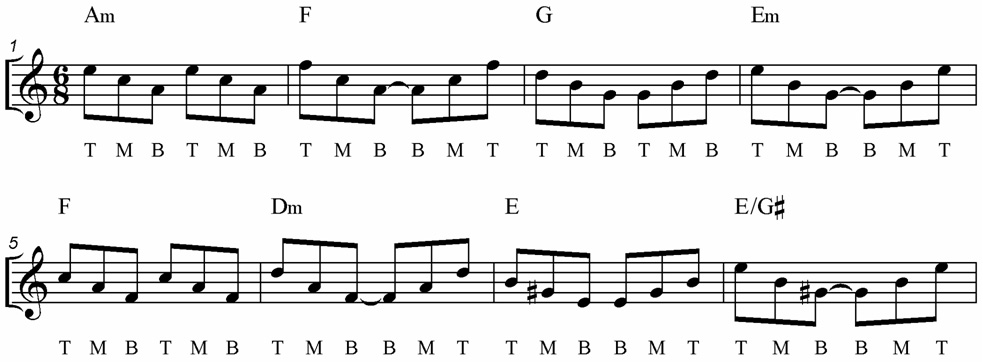The Pyramids Variations
Pyramids using Mixed Inversions
If we raise the top note of an A minor root position triad one step, we get a first inversion chord of the next chord in the Pyramids chord sequence – F major. The same is true of the G major and F major root position triads.

The little three-line diagrams between the chord symbols remind you that the two lower notes stay the same and the top one moves up. In bars 7 and 8, the bottom note of the root position E chord passes to the top to make a first inversion E chord.

The three-line voice movement diagram shows the bottom note crossing to the top.
Putting all eight bars together, we get the same Pyramids zigzag melody line as before, but now every melody note is the top note of a three-note chord.

If you break up the chords, you get more music out of them.

This example sounds good at a slow walking pace. The next section helps you understand what is being done, and shows how to finish this 16-bar version off.
BMT (bottom, middle, top) analysis
You will find it easier to make music out of chords if you think of their three notes as the bottom (B), middle (T) and top (T) notes. Using this ‘BMT analysis’, you ‘see’ the right hand notes like this.

Note that there are only two types of bars here: T M B T M B and T M B B M T. Sometimes the middle notes are tied and sometimes not.
We can use this BMT ‘shorthand’ description to indicate what happens in bars 13 to 16 (the ending) without having to write out all the notes. Try to play this.

Writing music down is very time-consuming. Any shorthand you can use to avoid writing music out in full is a great idea. Also, thinking about the patterns in music rather than the individual notes generates more ideas, a lot faster.
‘Slash chords’
In bar 8 of the music example written out on page 99, you see the chord symbol E/G# (“E over G sharp”). This is called a ‘slash chord’. You see in the music that the chord is E major, but the bass note (in the left hand) is not the root, E.
You use the ‘slash chord’ chord symbol to indicate that the bass note of a chord is a note other than the root. The chord symbol E/G# says “Play an E chord in the right hand with G# in the left hand.” The different bass note is usually the third or the fifth.
Mixed inversions in both hands
Of course, the left hand can use root position and first inversion chords in the same way as the right hand.

Break these two-handed chords up. Climb up both root position chords and then run down the first inversions.

We could look at the BMT analysis of this version in a grid, to help us complete it without any written music.

- The top line (Chord) will tell us which chord and inversion we are using.
- The middle line (RH) tells us the order to play the right hand chord tones in.
- The bottom line (LH) tells us the order to play the left hand chord tones in.
You read the whole table just like one line of music, so that it tells you which hand plays first. Check the grid against the music just above it and try to finish a 16-bar, A1A2 version of Pyramids using this pattern.
Then, add the tune on top of the rising/falling chord pattern.

Study the music carefully. The familiar simple Pyramids
melody is at the top with the stems up, and the rising and falling pattern of
the broken chords is underneath. Try to complete the version. The written-out
music for both these versions is in your Workbook.
|
OUT NOW! |
THE MUSICARTA BEAT & RHYTHM WORKBOOK At last! An effective approach to keyboard rhythm & syncopation skills. Learn more! |
ONLY $24.95! |
PYRAMIDS |